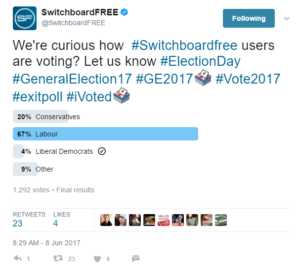How our Twitter poll reflected the actual general election results?
The snap 2017 general election is over, but the emotions evoked by the results are far from settling. The general opinion is that Prime Minister Theresa May did not have her gamble to call an early election justified, as the Conservatives failed to secure an overall majority in Parliament. The governing party won 318 seats of the required 326 which would have reaffirmed their credibility to govern alone.
Mrs. May reached a quick deal with the DUP (the Democratic Unionist Party) of Northern Ireland for support in the next parliament. With the 10 MPs the DUP will send to Westminster, a majority can be reached and the Tories are likely to stay in power. It is unclear, though, whether a former coalition agreement will be signed, or DUP will back the new Tories government under a “confidence and supply” agreement.
Anyways, it is too early to make certain claims. Time will tell how key political figures will play out the situation.
The praises after the results were announced have largely gone Labour way, despite the defeat. Party leader Jeremy Corbyn was congratulated on steering the Labour to a markedly improved performance compared to their result in 2015. The Labour will have 31 more seats in Westminster, increasing their parliamentary group to 261 MPs.
One of the early reasons cited for the Labour’s laudable performance, is the huge youth turnout registered on election day. First reports suggest that 72% of the voters aged 18-24 cast their vote. And as the British political tradition suggests, young people lean towards Labour, while older generations are, more or less, Conservative.
At SwitchboardFREE, we ran a poll on our Twitter account to check what are the voting intentions of our users.
We first want to express our deep gratitude to those nearly 1300 followers who took part in the poll in just 24 hours.
The results clearly suggested that the Labour Party had won the sympathies of our Twitter followers. 67% of the participants stated their intention to vote for Corbyn’s party, while only 20% supported the Conservatives. A modest 4% clicked the Liberal Democrats option.
What do we make of these figures? To be honest with you, we are not surprised with the results at all. It was plain to see during the campaign that social media was flooded with appeals to vote Labour. And younger people are known to be considerably more active on Twitter. Of over 15 million users in 2016, 65% were aged under 34. Stats is clear so it doesn’t take in-depth political knowledge to explain why Labour were the popular choice on new media.
We will now leave it to the political analysts to conduct their detailed research and determine the extent to which social media activity affected the election result.
Our humble conclusion is that the strong support for Labour and more liberal, left-wing politics on a global scale has turned into a continued trend on social media in recent years.
More importantly, we would like to thank everyone who went to the polling stations on Thursday to exercise their voting right. We were particularly happy to find out about the heightened activity among young voters. They clearly rebuffed the claims that youngsters are uninterested in politics. We wish to see them show the same zeal in their political engagement in the years to come.
You may also enjoy:
Why giving your business local presence matters?
The pros and cons of being a sole proprietor
How a conference call service can improve your business?
Have a look at what our virtual phone system can offer
